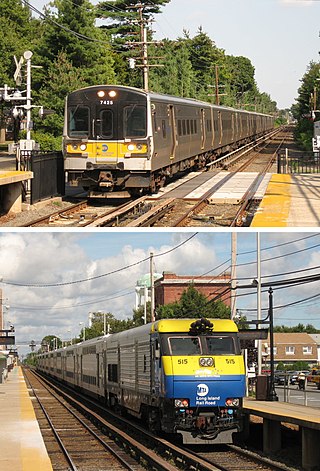
The Long Island Rail Road, often abbreviated as the LIRR, is a commuter rail system in the southeastern part of the U.S. state of New York, stretching from Manhattan to the eastern tip of Suffolk County on Long Island. With an average weekday ridership of 354,800 passengers in 2016, it is the busiest commuter railroad in North America. It is also one of the world's few commuter systems that runs 24/7 year-round. It is publicly owned by the Metropolitan Transportation Authority, which refers to it as MTA Long Island Rail Road. In 2022, the system had a ridership of 70,342,700, or about 253,800 per weekday as of the first quarter of 2023.

The Flushing–Main Street station is the eastern terminal on the IRT Flushing Line of the New York City Subway, located at Main Street and Roosevelt Avenue in Downtown Flushing, Queens. It is served by the 7 local train at all times and the <7> express train during rush hours in the peak direction.

The New York Connecting Railroad or NYCR is a rail line in the borough of Queens in New York City. It links New York City and Long Island by rail directly to the North American mainland. Amtrak, CSX, Canadian Pacific Railway, Providence and Worcester Railroad and New York and Atlantic Railway (NYAR) currently use the line. It runs from the Hell Gate Bridge over the East River to Fresh Pond Junction yard in Glendale in Queens. It was completed in 1917. Amtrak uses the northernmost section of the line from Sunnyside Junction in the Woodside section of Queens to the Hell Gate Bridge into the Bronx from which it follows the line north to Boston.
The IRT Flushing Line is a rapid transit route of the New York City Subway system, named for its eastern terminal in Flushing, Queens. It is operated as part of the A Division. The Interborough Rapid Transit Company (IRT), a private operator, had constructed the section of the line from Flushing, Queens, to Times Square, Manhattan between 1915 and 1928. A western extension was opened to Hudson Yards in western Manhattan in 2015, and the line now stretches from Flushing to Chelsea, Manhattan. It carries trains of the 7 local service, as well as the express <7> during rush hours in the peak direction. It is the only currently operational IRT line to serve Queens.
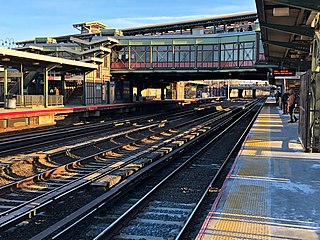
The Woodside station is a station on the Main Line and Port Washington Branch of the Long Island Rail Road (LIRR), located in the Woodside neighborhood of Queens in New York City. It is the first station passed by eastward trains from Penn Station and Grand Central Madison, and it is the only station in Queens shared by the Port Washington Branch and other LIRR branches. East of Woodside the two-track Port Washington Branch turns eastward, while the four-track Main Line continues southeast to Jamaica station.
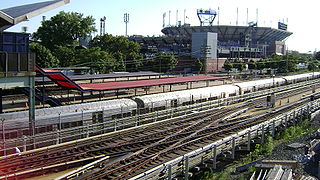
Mets–Willets Point is a station on the Long Island Rail Road's Port Washington Branch in Flushing Meadows–Corona Park, Queens, New York City. Prior to 2021, the station would normally be open only during New York Mets home games, the U.S. Open tennis tournament, major events, and emergencies. The station has been served full-time since 2023.
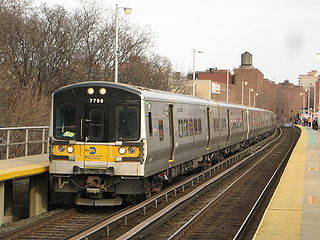
The Port Washington Branch is an electrified two-track rail line and service owned and operated by the Long Island Rail Road in the U.S. state of New York. It branches north from the Main Line at the former Winfield Junction station, just east of the Woodside station in the New York City borough of Queens, and runs roughly parallel to Northern Boulevard past Mets-Willets Point, Flushing, Murray Hill, Broadway, Auburndale, Bayside, Douglaston, Little Neck, and then crosses into Nassau County for stops in Great Neck, Manhasset, and Plandome before terminating at Port Washington.

Flushing–Main Street is a station on the Long Island Rail Road's Port Washington Branch in the Flushing neighborhood of Queens, New York City. The station is located at Main Street and 41st Avenue, off Kissena Boulevard.
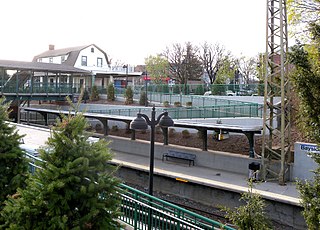
Bayside is a station on the Long Island Rail Road's Port Washington Branch in the Bayside neighborhood of Queens, New York City. The station is located at 213th Street and 41st Avenue, off Bell Boulevard and just north of Northern Boulevard, and is 12.6 miles (20.3 km) from Penn Station in Midtown Manhattan. The station is part of CityTicket.

The Long Island City station is a rail terminal of the Long Island Rail Road in the Long Island City neighborhood of Queens, New York City. Located within the City Terminal Zone at Borden Avenue and Second Street, it is the westernmost LIRR station in Queens and the end of both the Main Line and Montauk Branch. The station consists of one passenger platform located at ground level and is wheelchair accessible.

The Flushing River, also known as Flushing Creek, is a waterway that flows northward through the borough of Queens in New York City, mostly within Flushing Meadows–Corona Park, emptying into the Flushing Bay and the East River. The river runs through a valley that may have been a larger riverbed before the last Ice Age, and it divides Queens into western and eastern halves. Until the 20th century, the Flushing Creek was fed by three tributaries: Mill Creek and Kissena Creek on the eastern bank, and Horse Brook on the western bank.

The Central Branch is a rail line owned and operated by the Long Island Rail Road (LIRR) in the U.S. state of New York, extending from 40.734°N 73.470°W just east of Bethpage station to 40.696°N 73.341°W just west of Babylon station. It was built in 1873 as part of the Babylon Extension of the Central Railroad of Long Island (CRRLI), which was owned by Alexander Turney Stewart. The branch was mostly unused following the 1876 merger of the CRRLI and the LIRR, but in 1925 it was rebuilt and reconfigured to connect Bethpage and Babylon stations.
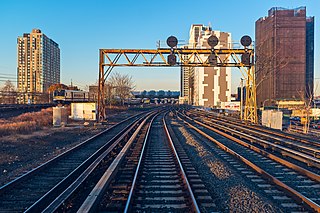
The Main Line is a rail line owned and operated by the Long Island Rail Road in the U.S. state of New York. It begins as a two-track line at the Long Island City station in Long Island City, Queens, and runs along the middle of Long Island about 95 miles (153 km) to the Greenport station in Greenport, Suffolk County. A mile east of the Long Island City station, the four tracks of the East River Tunnels join the two tracks from Long Island City; most Main Line trains use these tunnels rather than running to or from Long Island City.
The South Side Railroad of Long Island was a railroad company in the U.S. state of New York. Chartered in 1860 and first opened in 1867 as a competitor to the Long Island Rail Road, it was reorganized in 1874 as the Southern Railroad of Long Island and leased in 1876 to the LIRR. After a reorganization as the Brooklyn and Montauk Railroad in 1879 it was merged in 1889.
The Long Island Rail Road is a railroad owned by the Metropolitan Transportation Authority in the U.S. state of New York. It is the oldest United States railroad still operating under its original name and charter. It consolidated several other companies in the late 19th century. The Pennsylvania Railroad owned the Long Island Rail Road for the majority of the 20th century and sold it to the State in 1966.

Roslyn is a station on the Long Island Rail Road's Oyster Bay Branch. It is located at Lincoln Avenue and Railroad Avenue, west of Roslyn Road and south of Warner Avenue in Roslyn Heights, New York.
Central Railroad of Long Island was built on Long Island, New York, by Alexander Turney Stewart, who was also the founder of Garden City. The railroad was established in 1871, then merged with the Flushing and North Side Railroad in 1874 to form the Flushing, North Shore and Central Railroad. It was finally acquired by the Long Island Rail Road in 1876 and divided into separate branches. Despite its short existence, the CRRLI had a major impact on railroading and development on Long Island.

Winfield Junction is a junction between the Main Line and Port Washington Branch of the Long Island Rail Road in the Woodside section of Queens, New York City. Between 1854 and 1929, a station of the same name stood on this site.

The Flushing and North Side Railroad was a former railroad on Long Island built by Conrad Poppenhusen as a replacement for the former New York and Flushing Railroad. The railroad was established in 1868, was merged with the Central Railroad of Long Island in 1874 to form the Flushing, North Shore and Central Railroad, and was finally acquired by the Long Island Rail Road in 1876. Today the main line is known as the Port Washington Branch of the Long Island Rail Road.
The White Line was a short-lived branch of the Long Island Rail Road in western Queens County, New York. Officially known as the Newtown and Flushing Railroad, the line was chartered in 1871, but was only in service from 1873 to 1876.


















